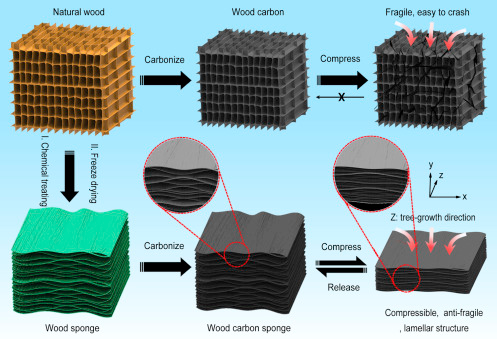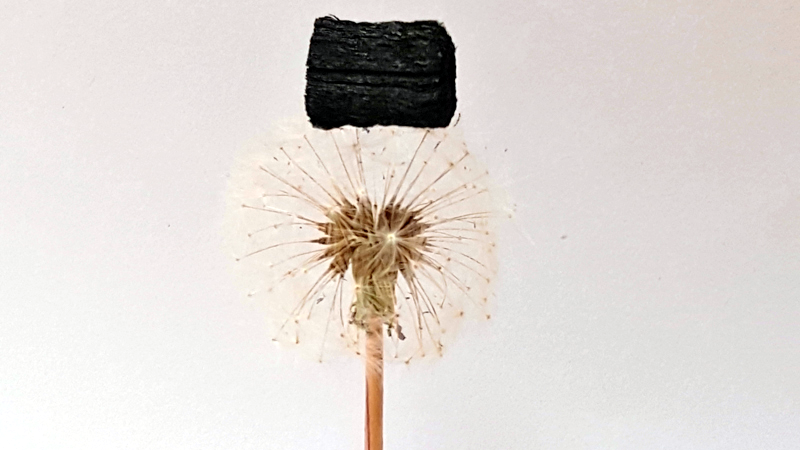Balsa wood has long been revered for its strength and lightweight composition, two properties that make it ideal for building model structures and airplanes. Researchers from the US and China have managed to make balsa even stronger and more useful. They’ve found a way to change its structure, turning it into a carbon sponge that’s strong enough to withstand repeated mechanical strain, but light enough to sit atop a dandelion gone to seed.
 Using common chemicals like lye and hydrogen peroxide, the scientists burned the hemicellulose and lignin fibers that make up balsa’s rectangular cell walls. Then they incinerated the sample at 1,000°C, which morphed the cellular structure into a cross between a helical spring and a honeycomb.
Using common chemicals like lye and hydrogen peroxide, the scientists burned the hemicellulose and lignin fibers that make up balsa’s rectangular cell walls. Then they incinerated the sample at 1,000°C, which morphed the cellular structure into a cross between a helical spring and a honeycomb.
Normally, carbonized wood just collapses under weight. But by first burning the cell fibers, the carbonization process results in a balsa carbon sponge capable of withstanding thousands of compressions before deforming. The researchers used the new material as part of a mechanical strain sensor prototype for wearable electronics, and they see a solid future for the material in water purification devices, supercapacitors, and rechargeable batteries.
This is big news for a society that’s trying to find more environmentally responsible ways to keep going full steam ahead in technological growth. Balsa trees grow fast, averaging 10+ feet per year, so this is a more sustainable alternative to graphene and carbon nanotubes. We’re excited to see what comes of this hack of nature. You can read the full paper here.
Even in its natural state, balsa is an interesting material. We once saw someone exploit its water retention abilities to make a rain-activated, shape-shifting prototype for roofing shingles.
Thanks for the tip, [Gervais].
















Let’s see what kind of high school physics class bridge project can be created with THIS balsa!
“Galloping Gertie” model bridge, now in carbonized corrugated cardboard…
Now soak it in resin for a carbon composite material!
A balsa sheet laminated with a single cloth of fiberglass om each side, is extremely touch.
GM used a Balsa laminate for the floor of the C5 and C6 Corvette. They switched to a foam-core laminate for the C7.
Just a note here… Balsa wood has to be harvested from wild growth trees. AFIK, it is not possible to cultivate the trees specifically.
I just googled balsa farm and there are places that grow it as a business.
In the diagram (which is from the original paper), I wonder if they mean ‘easy to CRUSH’ rather than ‘easy to CRASH’?
Looks to me like they turned balsa wood into a sponge, no longer a rigid material… so it survives compression, but deforms, so provides no longer the structural properties that it did…
FYI, Balsa is not the lightest wood (no one here said it was), but it is the lightest with any rigidity.
An article about caramelizing wood.
https://www.popularwoodworking.com/articleindex/roast-your-own
With the 1000C oven you can make this balsa carbon sponge and knives
for us mere mortals…
get some dope, “water it down” about 3:1, 4:1 with acetone, add glycerin, about a tablespoon to 250ml, then add powdered graphite until it’s like cream
when you treat 1/16″/1mm it becomes like icecream tub lid PVC
I’ve used it for gyrocopter blades, flap hinges
if you go to thicker balsa, 1/8″, 4mm, 5mm works well for structural elements and project cases
adding talc is a good idea as well, go 50/50 graphite, talc, use 800 freecut paper and it takes paint really well
the acid procedure sounds sort of like was used to make guncotton.